The Magic:The Gathering Sets vor The Brothers’ War waren in ihren begrenzten Umgebungen deutlich komplexer als gewöhnlich. Wir wurden von Streets of New Capenna und Double Masters 2022 herausgefordert, dreifarbige Decks zu erstellen, während Dominaria United auf die vollen fünf aufspritzen wollte.
Der Krieg der Brüder ist zu einem einfacheren Aufbau zurückgekehrt, mit zehn zweifarbigen Kombinationen, die um Ihre Aufmerksamkeit wetteifern. Egal, ob du im Draft oder Sealed spielst, du kannst mit dem Wissen, worauf du achten und was du vermeiden solltest, gewappnet in The Brothers’ War gehen.
Weiß/Blau:Soldier Tribal
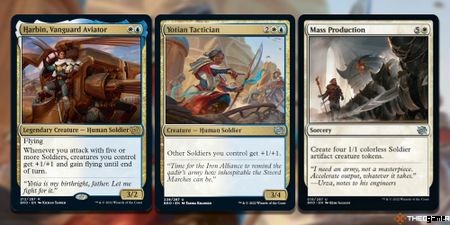
Einer der klarsten Archetypenentwürfe in The Brothers’ War ist das Kreaturentyp-Thema Soldat von Weiß und Blau. Der Plan ist einfach:Bringe so viele Soldaten wie möglich ins Spiel, bevor du deinen Gegner mit vielen Ausweichmanövern überfährst.
Der Wegweiser dafür ist Yotian Taktiker , der dich belohnt, wenn du weit gehst, indem er all deinen Soldaten +1/+1 gibt. Dies ist eine, die Sie gegen Ende eines Spiels fallen lassen sollten, wenn Sie bereit sind, den Sieg zu erringen, sonst wird es entfernt, als würde es niemanden etwas angehen.
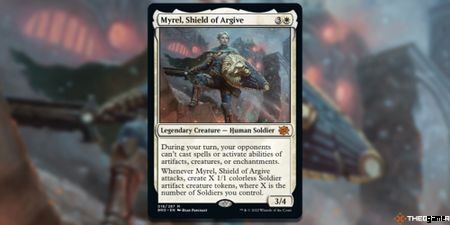
Es gibt viele Möglichkeiten, Soldaten herzustellen, wie z. B. Massenproduktion, Myrel, Schild von Argive; Siege Veteran, Platoon Dispenser, Skystrike Officer und Scrapwork Cohort. Von da an sollten Sie Wege finden, sie entweder aufzupeppen oder sie ausweichend zu machen, wie Harbin, Vanguard Aviator; Air Marshal, Aeronaut Cavalry und Bergungsagent . Wenn Sie dafür sorgen, dass die Soldaten kommen, sollten Sie genug Schwung bekommen, um Harbin auf das Schlachtfeld zu werfen und auf einmal hineinzuschwingen.
Blau/Schwarz:Macht ziehen
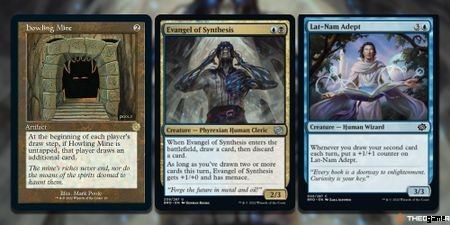
Eines der Dinge, in denen Blau und Schwarz beide am besten sind, ist das Ziehen vieler Karten, und so belohnt Sie der Blau/Schwarz-Archetyp dafür, dass Sie in jeder Runde mindestens eine zusätzliche Karte ziehen. Ausgeschildert von Evangel of Synthesis, Ein menschlicher Kleriker aus Phyrexia, der +1/+0 und Bedrohlichkeit erhält, wenn du eine Karte ziehst, ist ein Archetyp, den wir schon in anderen Farben gesehen haben – insbesondere in den blau/roten Farben von Thron von Eldraine.
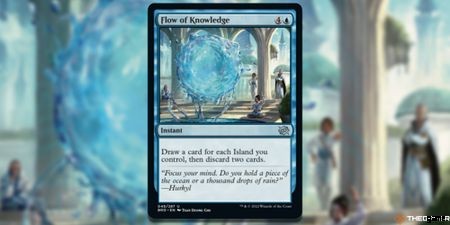
Es gibt unzählige Möglichkeiten, in The Brothers’ War Karten zu ziehen. Von einfachen Cantrip-Effekten wie Curate und Moment of Defiance , hin zu spezielleren Zeichenwerkzeugen wie Thraxodemon, Gruesome Realization, Fateful Handoff, Urza, Powerstone Prodigy; Take Flight und Flow of Knowledge . Sie haben auch Zugriff auf die Heulende Mine in den Retro-Frame-Nachdrucken, die Ihnen garantieren, dass Sie jede Runde eine zweite Ziehung erhalten, keine weitere Arbeit erforderlich.
Es gibt viele andere Auszahlungen als Evangel of Synthesis. Lat-Nam-Adept, Thopter-Mechaniker und gurgelnder Salbei alle erhalten +1/+1-Marken beim Ziehen deiner zweiten Karte, während Gixianischer Puppenspieler entzieht deinem Gegner zwei Lebenspunkte. Wenn du ein paar von ihnen auf das Schlachtfeld bringst, stellst du deinem Gegner eine ernsthafte Uhr auf, bevor sein ganzes Leben dahingerafft wird.
Schwarz/Rot:Artefaktopferung

Schwarz und Rot halten die Dinge traditionell für ihren Draft-Archetyp, wobei Rakdos das tut, was Rakdos am besten kann:Dinge opfern. Dies wird am besten durch den Entwurf des Wegweisers Junkyard Genius veranschaulicht , das ein Artefakt oder eine Kreatur opfern kann, um all deinen Kreaturen +1/+0 und Bedrohung zu verleihen.
Glücklicherweise sind viele der Opfergaben in diesem Set wie Powerstone Fracture, Thraxodemon, und Penregon Strongbull Alle erlauben es Ihnen, entweder Kreaturen oder Artefakte zu opfern. Dies funktioniert unglaublich gut in einer Draft-Umgebung, die so voll von Powerstone-Token ist – besonders für Penregon Strongbull, der die Powerstones verwenden kann, um für seine eigene Fähigkeit zu bezahlen, bevor er sie für einen potenziell gewinnenden Angriff opfert.
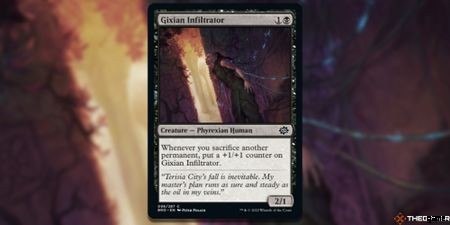
Achten Sie auch auf Gixian Infiltrator , der mit jeder geopferten bleibenden Karte größer wird, und Goblin Blast-Runner , das immer bedrohlicher wird, wenn du etwas opferst, um es schwieriger zu blocken.
Rot/Grün:Powerstone Midrange
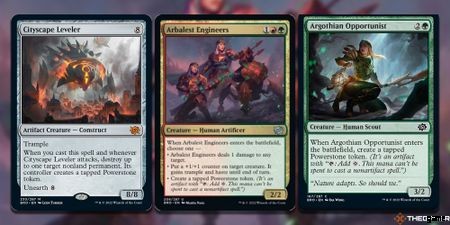
Von allen Archetypen in The Brothers’ War fühlt sich Rot/Grün am wenigsten konkretisiert an. Bei Powerstone Midrange dreht sich alles um die Herstellung von Powerstone-Tokens und deren Verwendung, um größere Zauber vor der Kurve zu wirken oder Kreaturen mit aktivierten Fähigkeiten zu stärken.
Der Wegweiser für diesen Archetyp ist Arbalest Engineers , was einen Teil der Flexibilität hervorhebt, die für ein gutes Midrange-Deck erforderlich ist. Es kann kleine Kreaturen ausschalten, die sonst lästige Blocker wären, es dir ermöglichen, mit einer größeren Kreatur durchzuschwingen, indem du ihr Trampelschaden gibst, oder einfach ein weiteres Powerstone-Token erstellen, um deine Strategie voranzutreiben. Mit Fallaji Excavation, Argothian Opportunist können Sie auch mehr Powerstone-Token herstellen und Halle von Tagin.
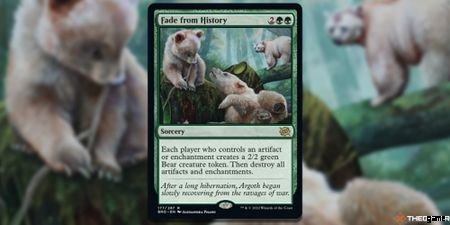
Midrange-Decks neigen dazu, sich in den frühen Stadien des Spiels darauf zu konzentrieren, das Brett zu kontrollieren, bevor sie tödlichen Schaden anrichten. Du kannst deinen Gegner mit Dingen wie Bushwhack, Excavation Explosion, Fog of War, managen und Fade from History, wodurch Sie genug Zeit haben, sich mit diesen Powerstone-Token einzudecken.
Powerstoken-Token können keine Zauber wirken, die keine Artefakte sind, aber zum Glück haben Rot und Grün Zugriff auf jede Menge mächtiger Artefaktkreaturen, mit denen Sie das Spiel beenden können. Ihr Ziel ist es, Ihre Token genug für Dinge wie Fallaji Dragon Engine, Cityscape Leveler, Boulderbranch Golem, Blitz Automaton, Artificer’s Dragon und Iron-Craw Crusher aufzubauen. Diese ins Spiel zu bringen, nachdem Sie das ganze Spiel damit verbracht haben, das Brett Ihres Gegners aufzuhalten, wird absolut verheerend sein.
Grün/Weiß:Artefakt-ETB
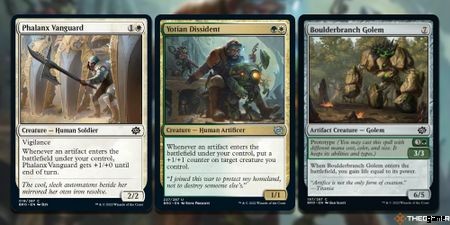
Diese Farben beziehen sich auf Fähigkeiten, die ausgelöst werden, wenn Artefakte ins Spiel kommen. Wenn man bedenkt, wie viele Artefakte dieses Set enthält, könnte es dank Karten wie seinem ungewöhnlichen Wegweiser Yotian Dissident möglicherweise eines der stärksten im Format sein , mit dem du +1/+1-Marken auf beliebige deiner Kreaturen legen kannst, wenn ein Artefakt eintritt.
Ähnlich wie der rot/grüne Archetyp profitiert grün/weiß enorm von Powerstone-Tokens, da sie leicht herzustellen sind und Spieler wie Yotian Dissident, Phalanx Vanguard, Thopter Architect, Perimeter Patrol und Sarinth Steelseeker auslösen können.
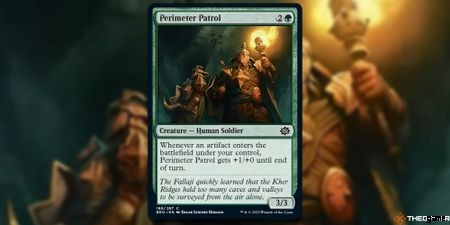
Sie sollten auch nach Artefakten Ausschau halten, die ihre eigenen ETB-Auslöser haben, um sicherzustellen, dass Sie noch mehr Wert erhalten. Kampfdrescher lässt dich eine Karte ziehen, Scrapwork Cohorte macht Kreaturenmarker, Boulderbranch Golem gibt Ihnen Leben und Woodcaller Automaton kann deine Länder beleben. Ihr Ziel hier ist es, Ihren Gegner mit so viel Wert wie möglich zu überfluten, also scheuen Sie sich nicht, diese teureren Zaubersprüche mit all den Powerstones, die Sie generieren, zu verprassen.
Weiß/Schwarz:Rekursive Aggro
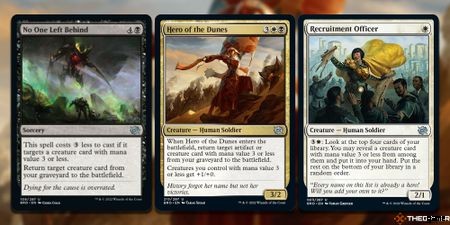
Uncharacteristically for white and black, The Brothers’ War’s Orzhov archetype uses graveyard recursion to drive an aggro strategy. You’ll be needing to keep the pressure up at all times with plenty of cheap creatures, while also making use of unearth to bring things back into play for one last swing.
The signpost for Recursive Aggro is Hero of the Dunes , who emphasises one key aspect of the archetype:you’ll want lots of creatures with mana values less than three. Things like Thraxodemon, Thran Vigil, Ambush Paratrooper, Airlift Chaplain, Powerstone Engineer, and Recruitment Officer make good choices for it.

You’ll need other reanimation enablers, such as No One Left Behind, Gixian Puppeteer, and Recommission , all of which work with small mana value creatures. For the bigger hitters later in the game, you’ll want to rely more on unearth. By dumping the likes of Platoon Dispenser, Tocasia’s Onulet, Cityscape Leveler, and Scrapwork Rager into your graveyard, before unearthing them at the right moment to cinch the game. If all else fails, you can always use Meticulous Excavation to bounce them back to your hand for a second try.
Blue/Red:Prowess

Blue and red are playing it safe for this set, bringing back one of its most popular archetypes with the debut of prowess as a deciduous keyword. Prowess is an aggressive strategy that relies on you casting lots of noncreature spells to beef up creatures like Dwarven Forge-Chanter, Monastery Swiftspear, and Wing Commando.
Although it doesn’t have prowess itself, the signpost for this archetype is Third Path Iconoclast , who keeps the attackers coming provided you can keep casting noncreature spells. Your goal is to flood the board with creatures, including as many copies of the set’s three prowess creatures as possible, before casing incredibly cheap spells like Goblin Firebomb, Weakstone’s Subjugation, Curate, Energy Refractor, Obliterating Bolt, Whirling Strike, and Machine Over Matter .

This is another archetype that really benefits from Powerstone tokens, as lots of the cheap spells you can cast to trigger prowess are artifacts. It might not be as flashy as the usual spellslinging approach the colours are known for, but if you need a Mishra’s Research Desk or Aeronaut’s Wings to finish the job, then so be it.
Black/Green:Graveyard

Black and green are sticking to the old Golgari classic:graveyard decks. It’s something the colours do in almost every set, and this time it’s being signposted by Skyfisher Spider , which helps you gain massive amounts of life when it dies depending on how many creatures are in your graveyard.
Self-mill is a vital part of this strategy, so make use of cards like Ravenous Gigamole, Blanchwood Prowler, Wasteful Harvest, and Burrowing Razermaw. You can also use some of the sacrifice outlets available to black, like Diabolic Intent, Thraxodemon, and Kill-Zone Acrobat to pad your graveyard out more if you need it
.
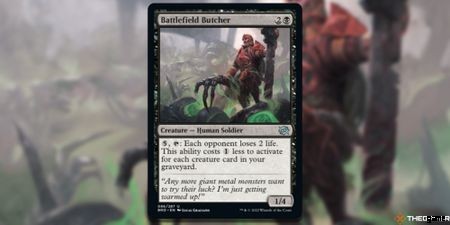
There are plenty of payoffs for having a full graveyard, such as Battlefield Butcher draining your opponent’s life, Ashnod, Flesh Mechanist using them as fodder to make Zombie tokens, Gaea’s Courser giving you card draw when you attack, and Gnarlroot Pallbearer being a potential game-winner by buffing something by the number of creatures in your graveyard.
In a pinch, don’t forget about unearth. Green doesn’t have as much access to it, but you’ve still got Perennial Behemoth to play lands out of your graveyard, and the likes of Terror Ballista and Ashnod’s Harvester to work with.
Red/White:Unearth Aggro
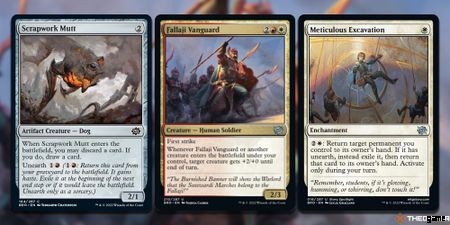
Red and white are often associated with aggro strategies, but The Brothers’ War is also borrowing an element of Strixhaven’s Lorehold college by giving us some graveyard recursion for good measure. As signposted by Fallaji Vanguard , you’ll be wanting to time your plays to ensure you can quickly swarm the board in a single turn for maximum impact.
Red and white has access to cheaper creatures with unearth than a lot of other colours, such as Yotian Frontliner, Scrapwork Mutt, Phyrexian Dragon Engine, Reconstructed Thopter, and Scrapwork Cohort . There’s also Platoon Dispenser , who can produce creature tokens and gives you card draw if you’ve got enough creatures in play. You’ll be aiming at casting these regularly and throwing them at your opponent, only to bring them back with unearth once your opponent has managed to kill them off.

This is another archetype that gets a lot of use out of Meticulous Excavation , as its ability allows you to functionally reset your unearth creatures and bring them back to your hand, ready to go again as soon as possible. If you’ve got Fallaji Vanguard in play, why not skip combat entirely by beefing one creature up a lot with its effect before throwing it at your opponent with Pyrrhic Blast ?
Green/Blue:Powerstone Ramp
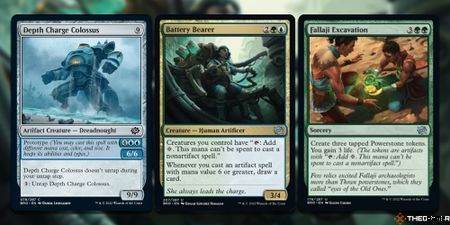
The final archetype is The Brothers’ War’s take on the ever-popular green/blue Simic Ramp. Though it does have some similarities to red/green and its Powerstone-focused playstyle, green/blue is entirely focused on just throwing out as many as possible, making massive amounts of mana, and using it to cast even bigger creatures.
The signpost here is Battery Bearer , who gives your creatures the same ability as a Powerstone, while also rewarding your big plays with card draw. You’ll need to go all-in on the Powerstone production for this, so keep an eye out for things like Fallaji Excavation, Geology Enthusiast, Argothian Opportunist, Splitting The Powerstone, and Stern Lesson .
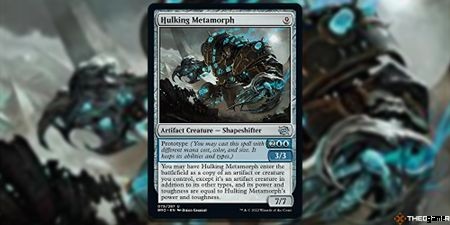
As Powerstones can’t be used to cast nonartifact spells, you’ll need to rely on either artifact creatures or activated abilities to get your board big enough to win. Blue and green have lots of artifact creatures with prototype available to it, like Rust Goliath, Depth Charge Colossus, Woodcaller Automaton, Hulking Metamorph, Cradle Clearcutter, and Boulderbranch Golem that should be easy to cast for their full cost in just a few turns.
For nonartifacts, make sure you’re grabbing things like Gwenna, Eyes of Gaea, who gets bigger for each big creature you cast and tap to produce mana, Argothian Sprite , with its activated ability putting two +1/+1 counters on it, or even Drafna, Founder of Lat-Nam to copy your big artifact creature spells for extra beaters.
NEXT:Magic:The Gathering – The Best Artifacts In The Brothers' War
